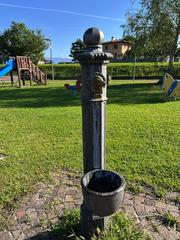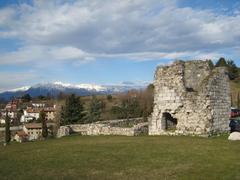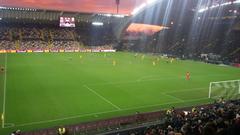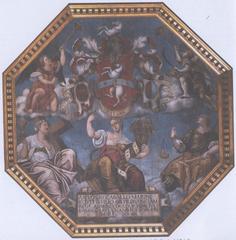Museo Friulano di Storia Naturale: Visiting Hours, Tickets, and Complete Visitor Guide to Udine Historical Sites
Date: 14/06/2025
Introduction
The Museo Friulano di Storia Naturale, located in the historic center of Udine, is a cornerstone of natural and cultural heritage in Friuli Venezia Giulia. Established in 1866 by Giulio Andrea Pirona, the museum has grown from a collection spread across local schools and institutions to an advanced center for scientific research, education, and community engagement. Today, it resides in the architecturally significant Ex Macello building, offering expansive exhibits and modern facilities to visitors from around the world.
This guide provides an in-depth overview of the museum’s history, collections, visiting hours, ticketing, accessibility, and travel tips. Whether you are a family, a researcher, or a traveler exploring Udine’s historical sites, the Museo Friulano di Storia Naturale is an essential stop that promises both education and inspiration.
For up-to-date visitor information, consult the museum’s official website, the Comune di Udine portal, and ArcheoCartaFVG.
Table of Contents
- Introduction and Museum Overview
- Historical Evolution and Collections
- Visiting Hours, Tickets, and Accessibility
- Scientific and Cultural Significance
- Educational Programs and Community Engagement
- Nearby Attractions and Travel Tips
- Frequently Asked Questions (FAQ)
- Practical Information and Contact
- Conclusion and Visitor Summary
- References
1. Introduction and Museum Overview
Nestled among Udine’s most significant historical sites, the Museo Friulano di Storia Naturale (MFSN) offers a journey through the natural world, from prehistoric fossils and minerals to rich botanical and zoological collections. The museum’s mission is to preserve and promote the natural heritage of Friuli Venezia Giulia through research, exhibitions, and inclusive educational activities.
2. Historical Evolution and Collections
Foundation and Development
The museum was founded in 1866, following the annexation of Friuli to Italy. Giulio Andrea Pirona, a physician and passionate naturalist, spearheaded the creation of the museum’s foundational collections, focusing on botany, paleontology, and geology (patrimonioculturale.regione.fvg.it). For decades, these collections were scattered across local educational institutions until the museum acquired its first dedicated space in 1949.
Growth and Modernization
After the 1976 Friuli earthquake, the museum moved to Palazzo Giacomelli and underwent significant modernization, emphasizing conservation, research, and public education (archeocartafvg.it). In 2016, the museum was permanently relocated to the Ex Macello, an early 20th-century former municipal slaughterhouse, providing expansive and accessible exhibition spaces (museofriulanostorianaturale.it).
Collections Overview
The museum houses over 1.3 million specimens across several disciplines:
- Botany: 234,823 specimens
- Geo-Paleontology: 127,163 specimens
- Mineralogy and Petrology: 13,000 specimens
- Paleontology and Anthropology: 225,201 specimens
- Zoology: 20,460 vertebrates and 691,441 invertebrates
A specialized library (over 85,000 titles) and a mediateca (over 22,000 images) support research and public education (artsupp.com).
3. Visiting Hours, Tickets, and Accessibility
Opening Hours
- Tuesday to Sunday: 9:00 AM – 6:00 PM
- Closed: Mondays and public holidays
- Special tours: Some areas, such as archives, are accessible by reservation only, with guided tours every second Thursday of the month (Comune di Udine – Visita guidata).
Ticket Information
- Permanent collection: Free admission
- Special exhibitions/events: Free, but reservation required for popular events like Darwin Day
- Combined ticket: €15 for access to multiple Udine museums, valid for 7 days
- Group and educational visits: Advance booking recommended
Accessibility
- Physical access: Wheelchair accessible, with elevators and accessible restrooms
- Sensory environment: Well-lit and quiet, suitable for visitors sensitive to noise or light
- Information: Italian signage; English and German materials available
- Assistance: Contact the museum ahead to arrange accommodations for special needs
4. Scientific and Cultural Significance
The museum is a leading center for the study and preservation of Friuli Venezia Giulia’s natural heritage (thegoguy.com). Its collections document geological, botanical, zoological, and anthropological history, supporting research in biodiversity, paleoenvironments, and human evolution.
As a statutory “cultural institution of scientific research and education,” the MFSN serves a broad audience, from families and school groups to international scholars (archeocartafvg.it).
5. Educational Programs and Community Engagement
The museum is renowned for its dynamic educational outreach, offering:
- Guided tours: Available on weekends or by appointment
- Workshops and temporary exhibitions: Including hands-on labs and interactive displays
- Annual events: Such as Darwin Day, featuring lectures, book presentations, and field excursions (friulioggi.it)
- School partnerships: Curriculum-integrated projects and teacher training
- Public resources: The library and mediateca are open to all
6. Nearby Attractions and Travel Tips
Combine your museum visit with nearby Udine cultural sites:
- Udine Castle
- Piazza Libertà
- Cathedral of Udine
The museum’s central location makes it accessible on foot, by public transport, or by bicycle. Street parking is available, but public transport is recommended during busy periods.
Travel Tips:
- Visit on weekdays for a quieter experience
- Book guided tours in advance, especially for groups and schools
- Allow 1.5–2 hours for a thorough visit
- Use translation apps or arrange for English-speaking guides if needed
7. Frequently Asked Questions (FAQ)
Q: What are the museum’s opening hours?
A: Tuesday to Sunday, 9:00 AM–6:00 PM; closed Mondays and public holidays.
Q: Is admission free?
A: Yes, for the permanent collection. Reservations may be required for special events.
Q: Are guided tours available?
A: Yes, on weekends or by appointment. Special archive tours are available monthly.
Q: Is the museum wheelchair accessible?
A: Yes, with accessible restrooms and elevators.
Q: Can I take photos?
A: Photography is permitted in most areas without flash or tripods.
Q: How do I get there?
A: The museum is centrally located at Via Cecilia Gradenigo Sabbadini, 22–32, Udine. It is accessible by public transport and within walking distance from major city sites.
Q: What other attractions are nearby?
A: Udine Castle, Piazza Libertà, and the Diocesan Museum are all close by.
8. Practical Information and Contact
- Address: Via Cecilia Gradenigo Sabbadini, 22–32, 33100 Udine, Italy
- Phone: +39 0432 1273211
- Email: [email protected]
- Website: Museo Friulano di Storia Naturale
- Comune di Udine Portal: https://www.comune.udine.it/openpa/object/13632
9. Conclusion and Visitor Summary
The Museo Friulano di Storia Naturale is a vital institution in Udine, seamlessly blending scientific research, cultural preservation, and public education. Its rich collections, engaging exhibitions, and commitment to accessibility make it a highlight for anyone interested in the natural history and heritage of Friuli Venezia Giulia.
Visitor Tips:
- Check the official website regularly for updates on opening hours, ticket reservations, and events.
- Download the Audiala app for multimedia guides and exclusive content.
- Plan your itinerary to include other Udine historical sites for a full cultural experience.
10. References
- Museo Friulano di Storia Naturale Visiting Hours, Tickets & History: A Comprehensive Guide to Udine Historical Sites, 2025, (Museo Friulano di Storia Naturale Official Site)
- Museo Friulano di Storia Naturale in Udine: Visiting Hours, Tickets, and Collections Overview, 2025, (Museo Friulano di Storia Naturale Exhibitions)
- Visiting Museo Friulano di Storia Naturale in Udine: Hours, Tickets, Accessibility, and Visitor Guide, 2025, (Comune di Udine)
- Museo Friulano di Storia Naturale: Visiting Hours, Tickets, and Cultural Highlights in Udine, 2025, (Museo Friulano di Storia Naturale)
- ArcheoCartaFVG - Udine Museo Friulano di Storia Naturale, 2025, (ArcheoCartaFVG)
- Comune di Udine – Visita guidata Dietro le quinte, 2025, (Comune di Udine – Visita guidata)
- FriuliOggi - Museo Friulano Storia Naturale Darwin Day Programma Eventi 9 Febbraio 2025, 2025, (FriuliOggi)
- TheGoGuy - Best Things to Do in Udine, Italy, 2025, (TheGoGuy)
Explore more about Udine’s rich heritage and plan your visit today at the Museo Friulano di Storia Naturale, with support from the Comune di Udine and ArcheoCartaFVG.



